
201
Specific results reported in Chapter 2 are published in the following papers:
Shapovalova, A.I. Age-related changes in expression levels of markers of close contacts in women after myomectomy / A.I. Shapovalova, V.O. Polyakova, T.S. Kleimenova // Siberian Journal of Life Sciences and Agriculture. – 2021. – Vol.13, N 2. – P. 32-46 [67].
Shapovalova, A.I. Expression of signaling molecules (p53, type II collagen, VEGF and VEGFR) in biopsies of intact myometrium in women of different ages / A.I. Shapovalova, V.O. Polyakova, T.S. Kleimenova // Doctor. – 2021. – Vol.32, N 9. – P. 76-79 [71].
3.3 Expression of p16 apoptosis and cellular aging factor
in post-surgery uterine scar area in women of different ages
A study of human uterine leiomyoma cell culture has shown that |
an |
inhibitor |
of the Akt signaling pathway prevents the replicative aging of cells |
by |
reducing |
the synthesis of pro-apoptotic protein p16 and associated factors p21 and p53 [105].
Other studies have also shown |
the role of pro-apoptotic |
protein |
p16 |
in |
the aging |
|||
of female |
reproductive |
system tissue cells, |
mainly endometrium |
[77;124]. Thus, |
||||
the marker |
of cellular |
aging and |
apoptosis |
p16 may be |
important |
for |
assessing |
|
the condition of tissues in the area of post-surgery scar on the uterus.
In our study, it was found that the area of p16 expression in the area of the post-
surgery uterine scar in women aged 36-46 years was 6.7 times higher than in women aged 29-35 years, the differences are statistically significant (Figure 3.6). The average brightness of p16 protein expression in the post-surgery scar area in women of group 2
was 1.6 times higher compared to this indicator in younger women of group 1
(Figure 3.5). These data allow us to conclude that of all the studied markers of cellular aging and apoptosis (p53, p21, p16), the greatest increase in terms of expression area and average expression brightness was found for the p16 protein in the area of the post-surgery uterine scar. It should be noted that the expression area of all studied
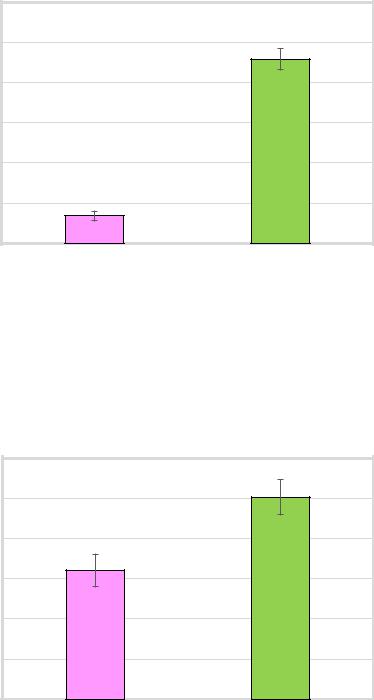
202
pro-apoptotic markers of aging increased in the area of post-surgery uterine scar
with increasing age of women.
|
|
3 |
|
- |
|
|
* |
post |
|
|
|
|
2,5 |
|
|
the |
|
|
|
% |
|
|
|
pattern in |
scar area, |
2 |
|
1,5 |
|
||
|
|
||
expression |
surgery |
1 |
|
0,5 |
|
||
р16 |
|
|
|
|
|
|
|
|
|
0 |
|
|
|
Group 1 (29-35 years) |
Group 2 (36-46 years) |
Figure 3.6. – Comparative assessment of p16 protein expression pattern in the post-surgery scar area in women of different ages.
* – p 0.05 – compared to group 1
Mean brightness of р16 expression |
|
30 |
* |
in post-surgery scar area, c.u. |
25 |
|
|
20 |
|
||
15 |
|
||
10 |
|
||
5 |
|
||
|
|
||
|
|
0 |
|
|
|
Group 1 (29-35 years) |
Group 2 (36-46 years) |
Figure 3.7 – Comparative assessment of mean p16 expression brightness of in the post-surgery scar area in women of different ages.
* – p 0.05 – compared to group 1
Рекомендовано к изучению сайтом МедУнивер - https://meduniver.com/
203
Specific results reported in Chapter 2 are published in the following papers:
Shapovalova, A.I. Age-related changes in expression levels of markers of close contacts in women after myomectomy / A.I. Shapovalova, V.O. Polyakova, T.S. Kleimenova // Siberian Journal of Life Sciences and Agriculture. – 2021. – Vol.13, N 2. – P. 32-46 [67].
Shapovalova, A.I. Expression of signaling molecules (p53, type II collagen, VEGF and VEGFR) in biopsies of intact myometrium in women of different ages / A.I. Shapovalova, V.O. Polyakova, T.S. Kleimenova // Doctor. – 2021. – Vol.32, N 9. –
P.76-79 [71].
3.4Expression of VEGF vascular endothelial growth factor and VEGFR receptor in the post-surgery uterine scar area in women of different ages
Evaluation of the expression of vascular endothelial growth factor VEGF and its VEGFR receptor in the post-surgery scar area is of great diagnostic importance. The
processes |
of angiogenesis are |
inextricably linked |
with |
the formation |
of a well- |
||||
established post-surgery scar on the uterus after |
conservative myomectomy. This |
||||||||
indicates that apoptotic processes become more |
active with age, but only in part |
||||||||
of the scar, |
and occupy |
a larger area |
compared |
to what |
is typical |
for |
the study |
||
of the material obtained |
from |
women |
in group |
1. |
The |
indicators |
of the average |
||
brightness of the expression of VEGF and its VEGFR receptor are also not of a local distribution, but are verified throughout the drug.
Microphotographs (Figures 3.8, 3.9) show the results of an immunohistochemical study of VEGF and VEGFR expression in the area of a post-surgery scar on the uterus after conservative myomectomy in age groups.
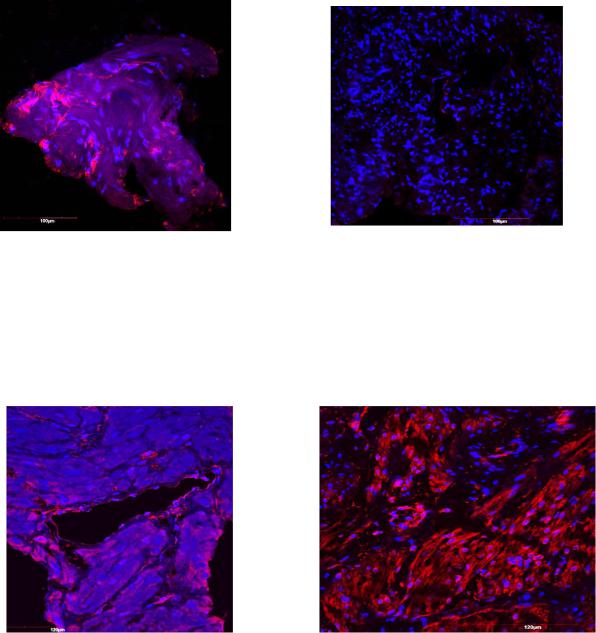
204
А B Figure 3.8 – VEGF expression in the two age groups
A – Group 1, B – Group 2. Cell nuclei were stained with DAPI – blue fluorescence, VEGF expression – red fluorescence (Alexa 647), ×200
А B Figure 3.9 – VEGFR expression in the two age groups.
А – Group 1, B – Group 2. Cell nuclei were stained with DAPI – blue fluorescence, VEGFR – red fluorescence (Alexa 647), ×200
According to the literature, it is known that neoangiogenesis factors are regulators of tissue repair, depending on the structure and receptor specificity, they can also contribute to the activation of the inflammatory process and scarring of tissue. The results of morphometric analysis of VEGF and VEGFR showed a significant decrease in the expression area of these molecules by 1.5 and 5.1 times, respectively, in the tissue
Рекомендовано к изучению сайтом МедУнивер - https://meduniver.com/
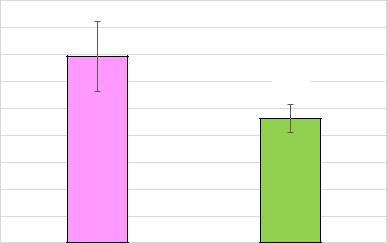
205
of post-surgery uterine scars in women aged 36-46 years when compared with patients of the younger age group (Figures 3.10, 3.12). The average brightness of VEGF and VEGFR expression in the samples of post-surgery myometrial scars decreased with an increase in the age of patients by 2.8 and 4.3 times, respectively (Figures 3.11, 3.13).
The data obtained confirm the results of other studies, indicating that at a younger age, neoangiogenesis in the uterus occurs more pronounced and decreases by 1.4 times after 36 years. Our studies revealed a statistically significant decrease in the expression of VEGF and VEGFR in post-surgery uterine scars with age. This may indicate that there is a constant formation of a vascular bed in the scar area, which makes it possible to evaluate the scar as a structure that is supplied with blood. The data obtained allow us to make a forecast about how pregnancy will proceed in women with the uterine scar.
|
18 |
|
in the % |
16 |
|
14 |
|
|
VEGF expression pattern post-surgery scar area, |
|
|
12 |
* |
|
10 |
|
|
8 |
|
|
6 |
|
|
4 |
|
|
2 |
|
|
|
0 |
|
|
Group 1 (29-35 years) |
Group 2 (36-46 years) |
Figure 3.10 – Comparative assessment of VEGF expression pattern in the post-surgery scar area in women of different ages
* – p 0.05 – compared with group 1
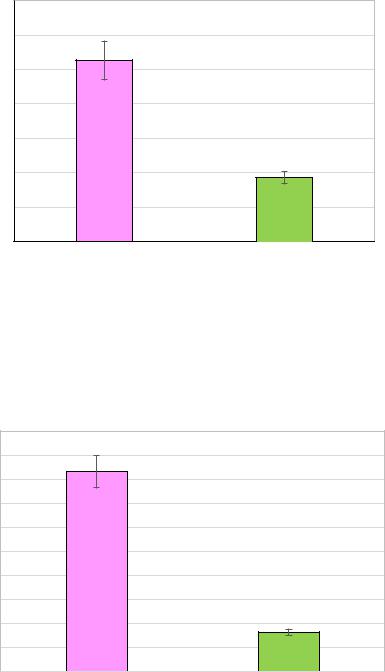
|
|
|
206 |
|
|
|
|
35 |
|
Mean brightness of VEGF |
expression in post-surgery scar |
|
30 |
|
|
25 |
|
||
area, c.u. |
20 |
|
||
15 |
|
|||
|
* |
|||
10 |
|
|||
5 |
|
|||
|
|
|
|
|
|
|
|
0 |
|
|
|
|
Group 1 (29-35 years) |
Group 2 (36-46 years) |
Figure 3.11 – Comparative assessment of mean VEGF expression brightness in the post-surgery scar area in women of different ages
* – p 0.05 – compared with group 1
|
|
20 |
|
the |
|
18 |
|
in % |
16 |
|
|
VEGFR expression pattern |
post-surgery scar area, |
|
|
14 |
|
||
12 |
|
||
10 |
|
||
8 |
|
||
6 |
* |
||
4 |
|
||
2 |
|
||
|
|
0 |
|
|
|
Group 1 (29-35 years) |
Group 2 (36-46 years) |
Figure 3.12 – Comparative assessment of VEGFR expression pattern in the post-surgery scar area in women of different ages * – p 0.05 – compared to group 1
Рекомендовано к изучению сайтом МедУнивер - https://meduniver.com/

|
|
|
207 |
|
|
|
|
25 |
|
Mean brightness of VEGFR |
expression in post-surgery scar |
|
20 |
|
area, c.u. |
15 |
|
||
10 |
|
|||
|
* |
|||
5 |
|
|||
|
|
|||
|
|
|
0 |
|
|
|
|
Group 1 (29-35 years) |
Group 2 (36-46 years) |
Figure 3.13 – Comparative assessment of mean VEGFR expression brightness in the post-surgery scar area in women of different ages
* – p 0.05 – compared with group 1
It should be noted that higher values of the expression area and average brightness of VEGF and VEGFR in the samples of post-surgery myometrial scars in women aged 29-35 years indicate a high degree of vascularization of the postsurgery scar zone on the uterus after conservative myomectomy, which may be a favorable factor for rapid solid scarring.
Specific results reported in Chapter 3 are published in the following papers:
Age features of the expression of signal molecules – protein p53, collagen type II, VEGF and VEGFR in bioptates of intact myometry in uterine myoma / A.I. Shapovalova, A.A. Tsypurdeeva, M.I. Kakhiani, E.N. Popov, V.O. Polyakova // Molekulyarnaya meditsina. – 2019. – Vol.17, N 9. – P. 60–63 [14].
Shapovalova, A.I. Age-related changes in expression levels of markers of close contacts in women after myomectomy / A.I. Shapovalova, V.O. Polyakova, T.S. Kleimenova // Siberian Journal of Life Sciences and Agriculture. – 2021. – Vol.13, N 2. – P. 32-46 [67].
Shapovalova, A.I. Expression of signaling molecules (p53, type |
II collagen, VEGF and |
VEGFR) in biopsies of intact myometrium in women |
of different ages / |
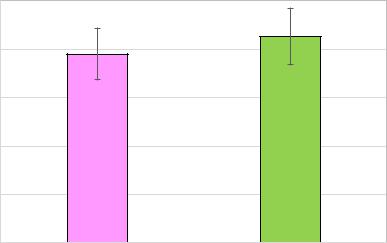
208
A.I. Shapovalova, V.O. Polyakova, T.S. Kleimenova // Doctor. – 2021. – Vol.32, N 9. –
P.76-79 [71].
3.5Type II collagen expression in the post-surgery uterine scar area
in women of different ages
It is known that collagen plays a significant role in cell proliferation, differentiation and migration, which can indirectly lead to thinning of the uterine wall. During the study, it was found that the expression area of type II collagen in the area of the post-surgery scar on the uterus in patients in the 1st age group was 7.81%, in the 2nd group – 8.53% and did not differ significantly (Figure 3.14).
collagen expression pattern |
|
10 |
|
post-surgery scar area, % |
8 |
|
|
6 |
|
||
4 |
|
||
|
|
||
Type II |
in the |
2 |
|
|
|
||
|
|
0 |
|
|
|
Group 1 (29-35 years) |
Group 2 (36-46 years) |
Figure 3.14 – Comparative assessment of type II collagen expression pattern in the post-surgery scar area in women of different ages
This may be due to the fact that the synthesis of type II collagen in the uterine scar tissue does not change with age. According to the literature, there is a change in the localization of collagens of types I, III, IV, V, VI in the uterine tissue. At the same time, it was noted that the distribution and amount of type II collagen in the stroma of the organ has no age characteristics [75], which is consistent with the results we obtained.
Рекомендовано к изучению сайтом МедУнивер - https://meduniver.com/
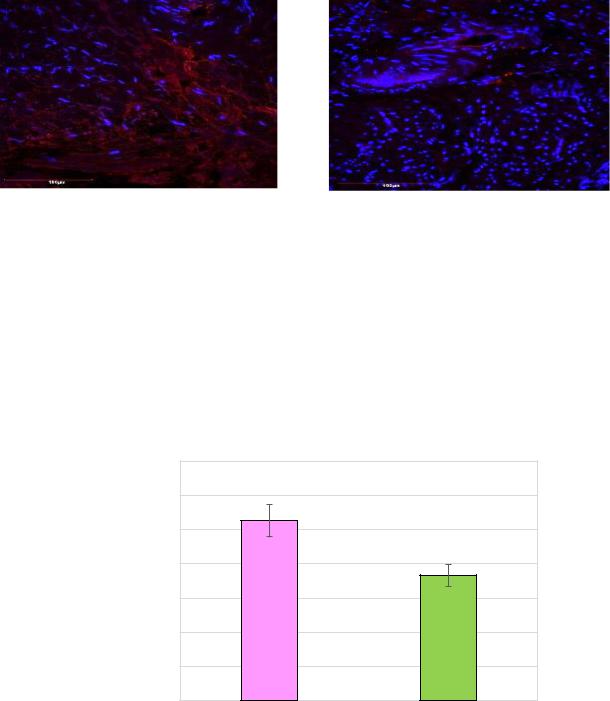
209
The microphotographs show the results of an immunohistochemical study of the expression of type II collagen in the area of a post-surgery scar on the uterus after conservative myomectomy in the study groups (Figure 3.15).
А B
Figure 3.15 – Type II collagen expression in two age groups.
A – 1 group. B – 2 group. Cell nuclei were stained with DAPI – blue fluorescence, type II collagen expression – red fluorescence (Alexa 647), ×200
Morphometric analysis data revealed a significant 1.4-fold decrease in the average brightness of type II collagen expression in post-surgery uterine scar samples in women of group 2 compared with this indicator in group 1 (Figure 3.16).
|
|
|
70 |
|
Mean brightness of type II collagen |
expression in post-surgery scar |
|
60 |
|
|
50 |
|
||
area, c.u. |
40 |
* |
||
|
||||
30 |
|
|||
20 |
|
|||
10 |
|
|||
|
|
|||
|
|
|
0 |
|
|
|
|
Group 1 (29-35 years) |
Group 2 (36-46 years) |
Figure 3.16 – Comparative assessment of mean type II collagen expression brightness in the post-surgery scar area in women of different ages
* – p 0.05 – compared with group 1
210
The results obtained indicate that the rate of formation of the collagen component of the uterine tissue decreases with age, which complicates the healing time of the postsurgery scar. Thus, the results obtained allow us to form recommendations for pregnancy planning in older women after laparoscopic myomectomy, which is associated with the development of possible complications in the area of post-surgery scar on the uterus.
Specific results reported in Chapter 3 are published in the following papers:
Age features of the expression of signal molecules – protein p53, collagen type II, VEGF and VEGFR in bioptates of intact myometry in uterine myoma / A.I. Shapovalova, A.A. Tsypurdeeva, M.I. Kakhiani, E.N. Popov, V.O. Polyakova // Molekulyarnaya meditsina. – 2019. – Vol.17, N 9. – P. 60–63 [14].
Shapovalova, A.I. Age-related changes in expression levels of markers of close contacts in women after myomectomy / A.I. Shapovalova, V.O. Polyakova, T.S. Kleimenova // Siberian Journal of Life Sciences and Agriculture. – 2021. – Vol.13, N 2. – P. 32-46 [67].
Shapovalova, A.I. Expression of signaling molecules (p53, type II collagen, VEGF and VEGFR) in biopsies of intact myometrium in women of different ages / A.I. Shapovalova, V.O. Polyakova, T.S. Kleimenova // Doctor. – 2021. – Vol.32, N 9. –
P.76-79 [71].
3.6Proliferative PCNA protein expression of in the post-surgery uterine scar area
in women of different ages
The study of the synthesis of the PCNA molecule in the uterine scar tissue allows
us to assess its proliferative activity. PCNA is |
considered as a marker |
of the development of fibrosis and malignancy of uterine tissue [141]. |
|
The microphotographs show the results of an |
immunohistochemical study |
of PCNA expression in the area of a post-surgery scar on the uterus after conservative myomectomy in women of age groups 1 and 2 (Figure 3.17).
Рекомендовано к изучению сайтом МедУнивер - https://meduniver.com/
